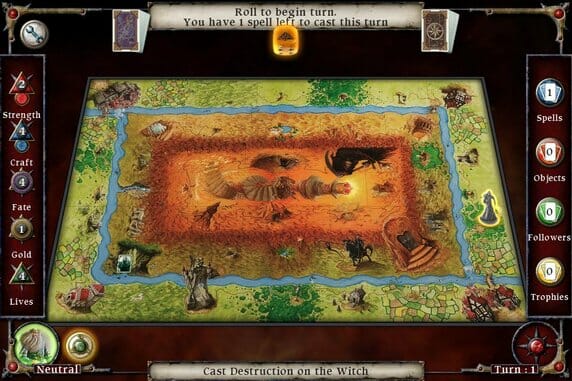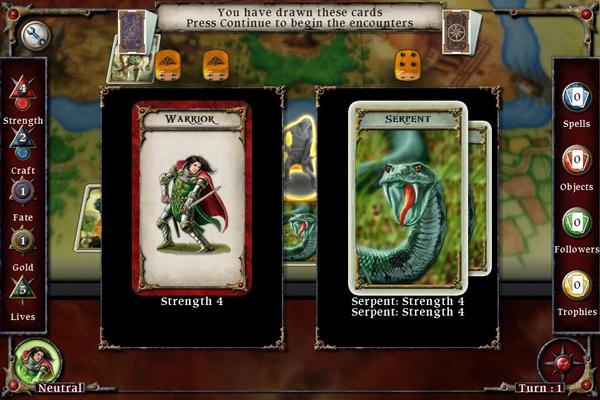
The key question, when translating a board game to the digital space, is how to improve upon the tabletop experience. What efficiencies or tweaks can a videogame offer that a board game can’t?
In Talisman: Prologue, the new digital version of Games Workshop’s classic board game, developer Nomad Games started with a counterintuitive premise: what if we made Talisman a single-player game? The result is a pleasant surprise—a refreshingly streamlined play experience.
First, a caveat: While Talisman: Prologue does tweak the classic Talisman formula, it does not significantly alter the ruleset. That means that a lot of the frustration inherent in the original game’s over-reliance on dice rolls is present here. If you hated the board game, it’s unlikely you’ll enjoy this version. It remains frustrating to plan a battle tactic only to be stymied by a bad roll, or to take twenty extra turns to complete an objective because you can’t manage to land on the right tile.
That said, Nomad has done a lot of smart things to improve the play experience, starting with the presentation. The Talisman board—beautifully rendered here—is laid out in three concentric tiers. The camera swoops, rotates and zooms as you select spaces, complementing the intuitive user interface. Taking on the role of one of ten characters with familiar classes like warrior, monk and assassin, players roll dice to move around each tier, battling monsters and encountering scenarios. Their success is governed largely by dice rolls in combination with their Strength and Craft stats, which change as they acquire objects, accrue allies and resolve encounters. You can also use Fate points to re-roll unfavorable results. Defeat enough monsters of a given type and you can trade them in to increase your stats. The ultimate goal is to be the first player to move to the last space of the center tier and win the final encounter.
Talisman: Prologue removes the game’s competitive element entirely; there are no AI players. Instead, you are presented with five missions per character, which progress in difficulty. An early mission might ask you to travel to a given outer tier space, pick up an item, and deliver it to another space, while later missions might task you with defeating a difficult monster in the center tier. Because you receive a Talisman (read: star) rating for each mission based on how many turns you took to complete it, there is some incentive to replay missions. Since “losing a turn” in a single-player game can often be meaningless, this scoring system also functions as Nomad’s solution to that problem.
The effect of this new mission structure is twofold: First, it highlights how shallow player-to-player interaction is in the original game, since you don’t miss it one whit here. More crucially, it is remarkably effective in teaching you the nuances of each character’s special abilities, helping you develop a particular play style for each. In the process, you also become familiar with the board, gaining insight into how spaces and tiers function. Talisman: Prologue does contain helpful tutorial pop-up text, as well as a robust and intuitive reference manual—but simply playing through the missions is often the best teaching tool. This is, after all, what most players want from a board game—to avoid spending hours reading and re-reading the manual, to learn by playing. And after playing Prologue, you’ll be exceptionally well-prepared for Nomad’s summer release of the full multiplayer version of Talisman.
It doesn’t hurt that Nomad’s implementation is visually attractive, with responsive touch controls. In the tabletop version of Talisman, the board can get cluttered easily as tiles become littered with cards. Talisman: Prologue neatly solves this problem by allowing you to view and zoom in on any tile at will. It also automatically tracks the number of charges remaining on certain cards—for example, the number of points that have been claimed from the Pool of Life. It also takes the work out of adjudicating clunky mechanics, like which order to resolve cards in. The UI is clean and communicative, which is exactly what you want from a digital board game. In a neat auditory flourish, each character has his or her own distinct background music that evokes his/her class—like a military march for the noble Warrior, or woodland chirps for the mystical Druid.
Technically, Talisman: Prologue is nearly flawless. I experienced no bugs or hiccups, and my save game easily and intuitively transferred between my iPhone and iPad via a free service called ScoreLoop. While the expanded real estate of the iPad display allows for more flavor text and breathing room, the game scales beautifully to the iPhone without any loss of fidelity or responsiveness.
Talisman: Prologue joins Ticket to Ride, Ascension and others among the growing pantheon of outstanding digital translations of board games. I hope other developers take note of Nomad’s successful experiment.
Talisman: Prologue was developed by Nomad Games and published by Thumbstar. It is available for iOS, Android and PC.
J.P. Grant is a Boston-based freelance writer whose work has appeared in Kill Screen, Gamers With Jobs, and other outlets. He blogs about games at Infinite Lag and is also on Twitter.

